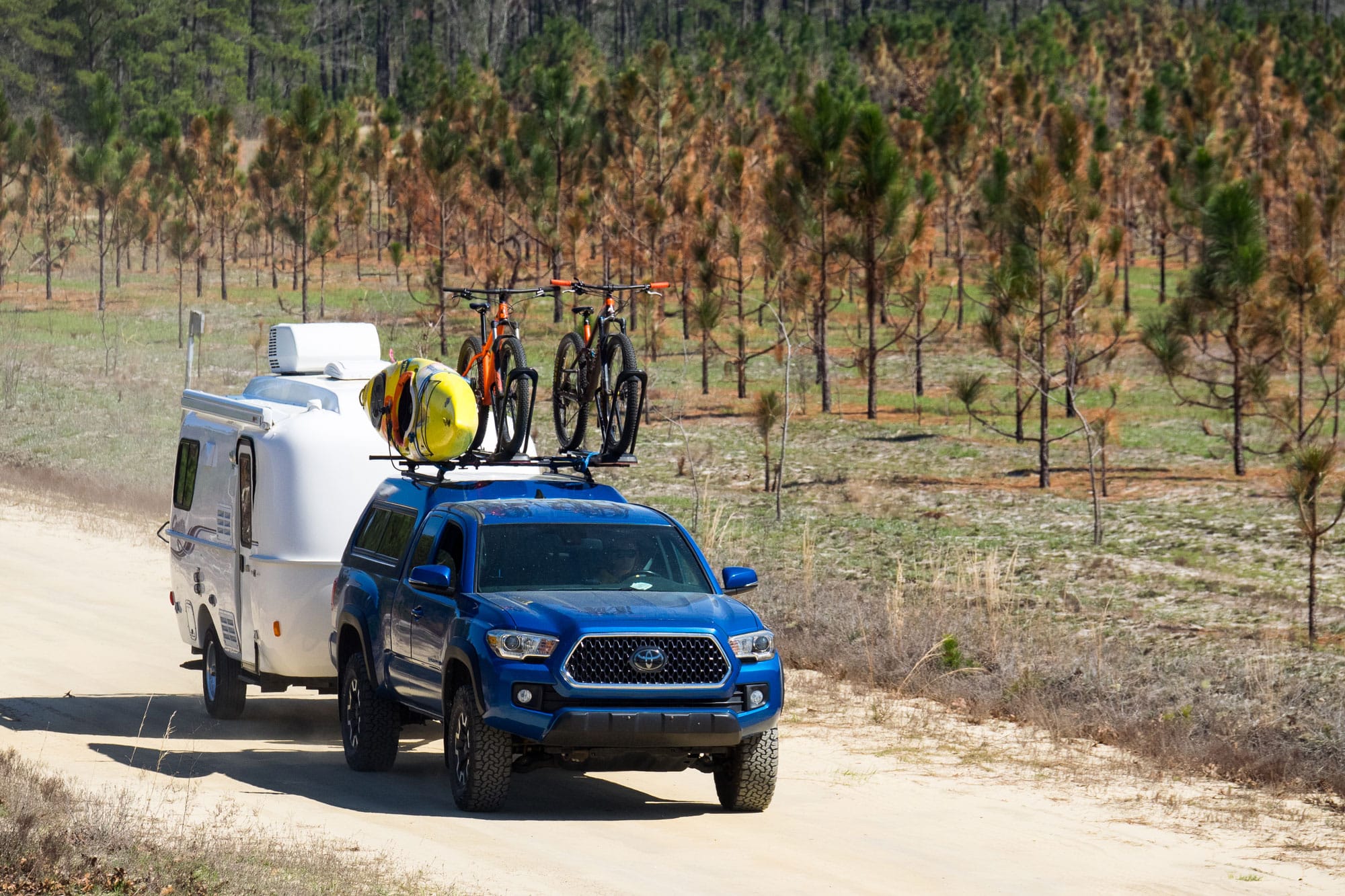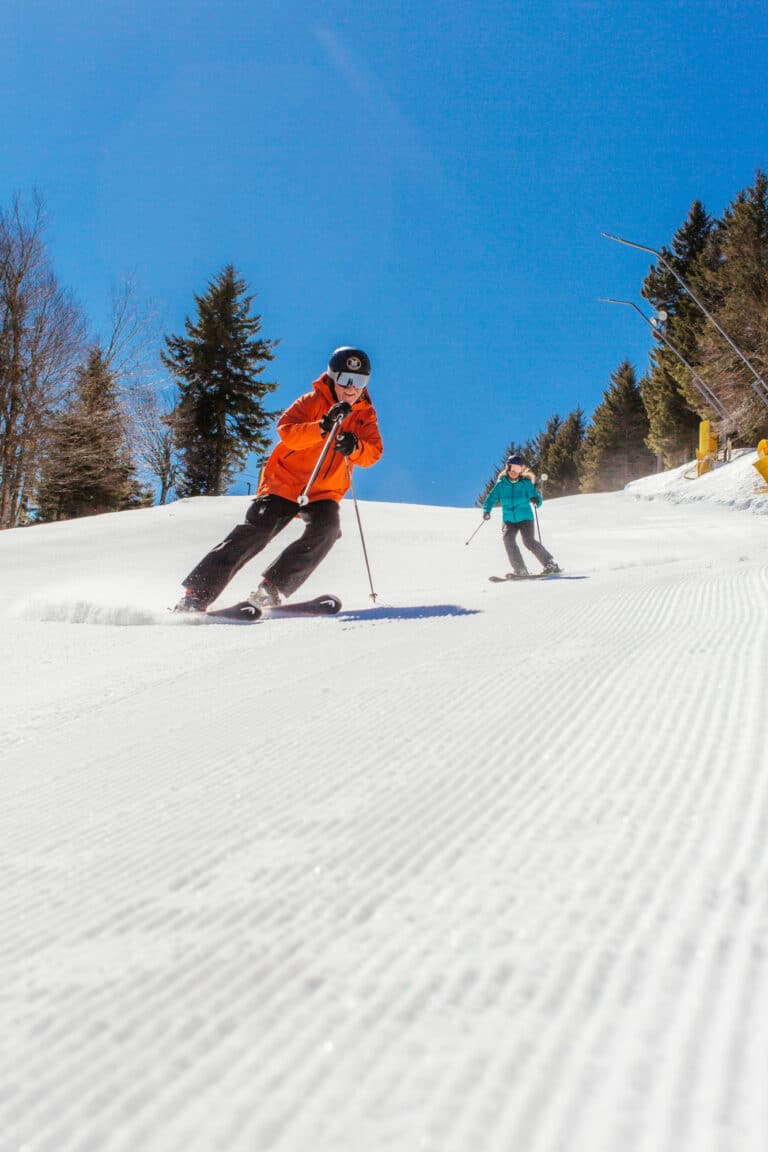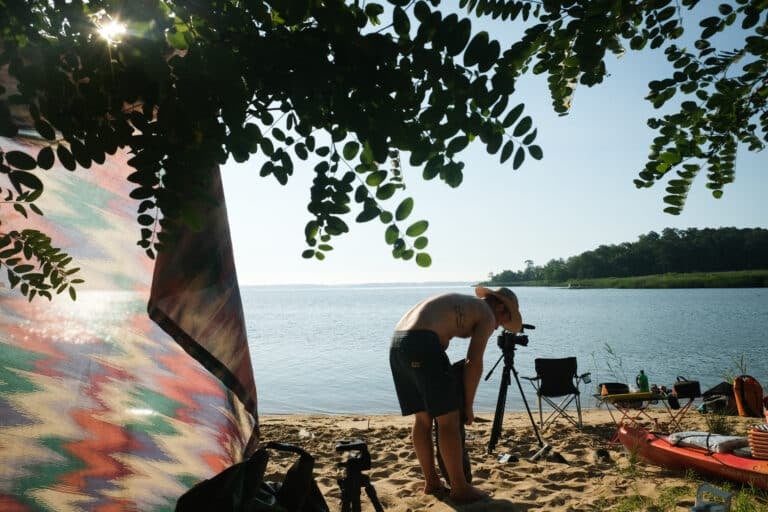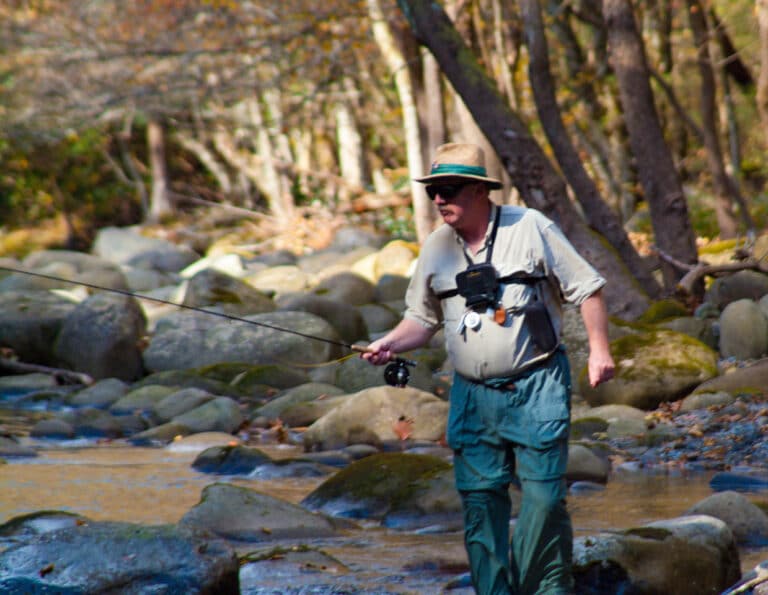A Shakedown Trip on Carolina’s Coastal Plain
The two-hour drive felt downright idyllic. We were towing our new camper along a country highway through farm fields, stands of pine trees, and gently rolling hills. Overhead, wispy clouds drifted through sunny blue skies. Warm air swirled in through my open window. My wife seemed happy. I felt happy. A friendly driver at a four-way intersection appeared happy, waving us through.
This was our very first camper adventure. A shakedown trip to one of our favorite places on the inner Coastal Plain. North Carolina’s Bladen County is a hidden gem of forested hills, excellent trails, undeveloped lakes, and winding rivers. Cruising along at a leisurely 55 MPH, even our gas mileage (14.5 mpg) was a pleasant surprise, despite our fully loaded rig. In addition to pulling the 17-foot Casita travel trailer, we had two mountain bikes and a hardshell kayak on the truck roof. In the bed was a deflated paddleboard and enough camping equipment and food to last our seven-day trip.
“You know, we used to dislike the driving part,” I said, thinking back on simpler days when we threw up a tent and quickly hit the river or trail. “But now it’s like a nice break from all the chaos.”
My wife looked at me. “Yeah, no kidding.”
On second thought, perhaps idyllic and happy weren’t the right words. Ever since buying the camper, the past three months have been a whirlwind of researching, cleaning, ordering, installing, testing, troubleshooting, planning, packing, misplacing, arguing, and reconciling. The past few days had been the most intense yet, with over a dozen trips to stores for last minute items. Yesterday, running way behind, we’d started crossing out to-do items to salvage the departure day: no testing the water system, no shower, no toilet, no sewer. We could use the campground facilities. Yet we still missed our ETD, and we began wondering aloud if the camper was a huge mistake that we needed to sell to stay sane. Honestly, a two-hour drive felt like a major relief.
“Maybe we should just drive this thing around for seven straight days,” I joked.
“That sounds great,” said my wife in a dazed voice.
We pulled into the wooded campground at Jones Lake State Park around 4:30 pm, later than hoped. Luckily, the gravel driveway at our full-hookup site was wide and flat and relationship approved. Backing in the trailer didn’t lead to the instant argument that sometimes happens with RV couples.
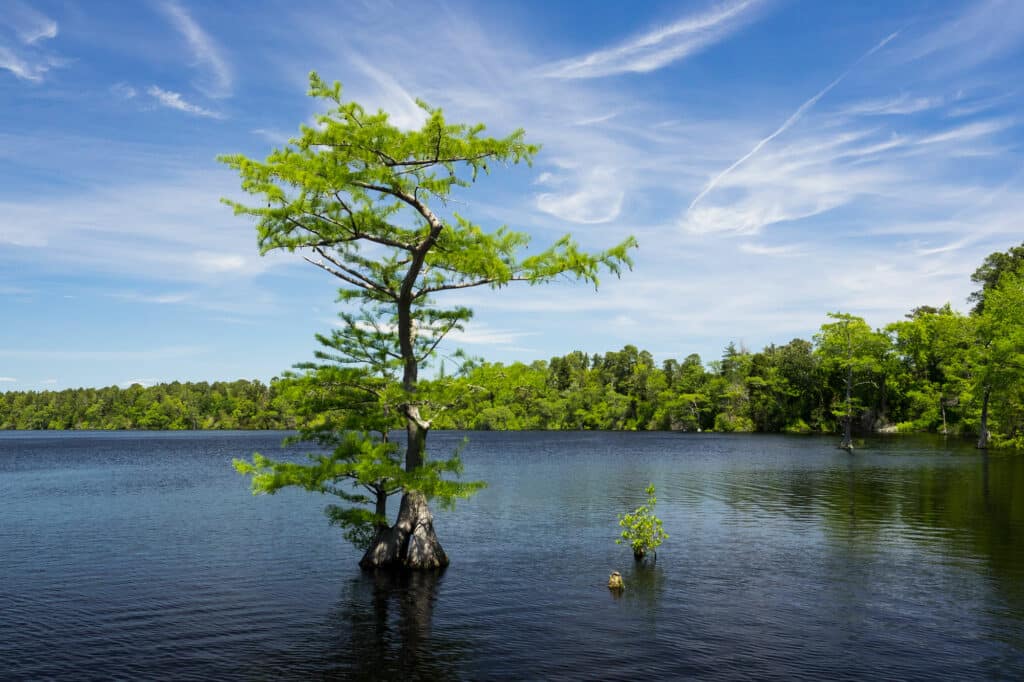
Set-up went well. Crank the manual tongue jack onto a wooden block. Set the stabilizing jack stands atop some Lynx levelers. Fumble with and drop the chain of 10,000 keys. We’re talking camper door keys, cargo hatch keys, hitch lock keys, padlock keys, bike rack keys, torture rack keys. Then I muttered for an equal amount of time about the urgency of “getting organized.”
Next came connecting to shore power. One consideration: don’t shock myself—even if a hospital visit sounded like a great chance to get away from it all. Joking aside, being careful with shore power is important. While there are many expensive reusable surge protectors, for now I chose a simple two-part kit from Progressive Industries. First, I plugged in the tester. A green light told me the circuit was fine to use. Then I plugged in a 30-amp surge module. If there’s a spike, the $20 disposable unit is toast, so I packed a second as a back-up. Next, I plugged in the camper and hoped for the best. Inside, we turned on the electrical power and refrigerator, which had been pre-cooling in our driveway for the past two days. Success!
With an hour of daylight to spare, we took a walk along Jones Lake. This park, and the surrounding Bladen Lakes State Forest, are part of nearly 60 square miles of rugged country with an interesting story. To start, the area holds some of the most intact and undisturbed Carolina Bays—round lakes with a mysterious geological origin. The federal government purchased the land for work programs during the Great Depression, and it was given to the state in the 1950s. Due to racial segregation, Jones Lake State Park was established as a park for African Americans. As a result of public ownership and limited funding, these 60 square miles remained in a relatively wild state. Before returning to camp, and firing up our new propane grill, we watched a stunning sunset reflected by the placid, tree-lined lake.
The next morning, the focus finally shifted from equipment shakedown to activities. Our first stop was mountain biking at Browns Creek Bike Park, built into sandy hills near the Cape Fear River on the outskirts of E-town. This is, without a doubt, the best singletrack on the Coastal Plain. Upon arrival, a fellow cyclist explained the ride had recently been expanded by the excellent trail builders from Cape Fear SORBA. Just shy of 16 miles, with a long-term plan to reach 25.
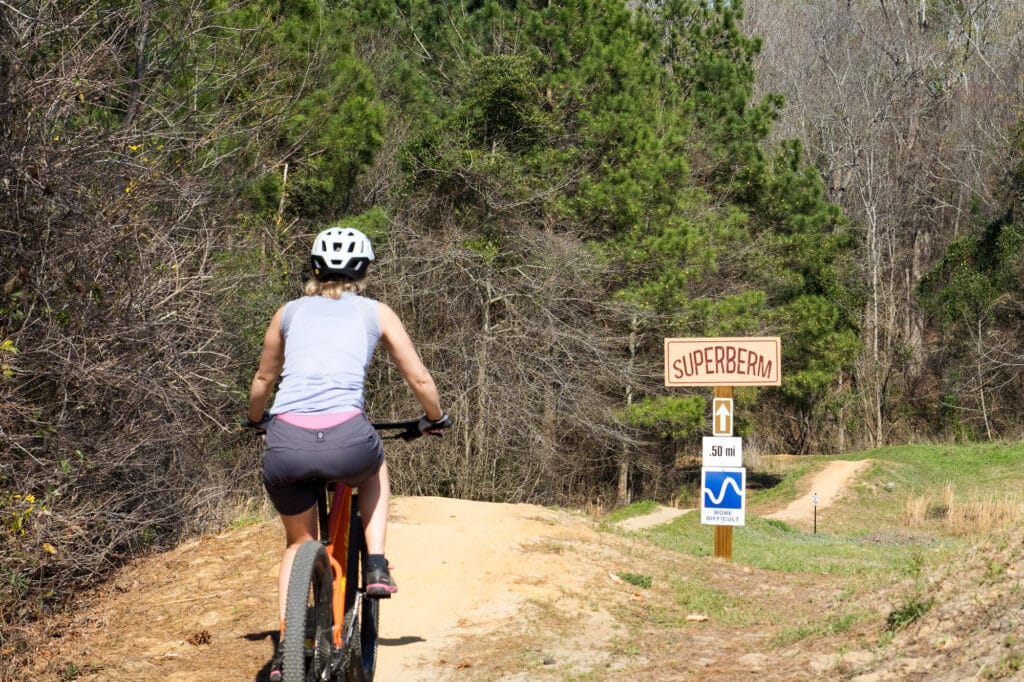
My wife had to send a few work emails, so I took off on a first lap. This ride has everything. A warm-up through bottomlands. Lung-bursting climbs. Flowy descents. A hill-top jump park. Huge wooden berms that feel like riding up the walls of a treehouse. And plenty of wooded mileage that resembles a surprising slice of Appalachia. When I returned to the truck, my legs were shaking. My wife had gotten out two of our new RV-lifestyle indulgences, folding recliner chairs. We had lunch under pine trees before hitting the trail for another lap.
That afternoon we had hoped to paddle Jones Lake, but tired legs and stiff winds nixed that plan. Instead, we pivoted back to the shakedown with a trip to the friendliest small-town Walmart in the world. When we asked where to find something, this staff didn’t just laugh, as if a superstore was some unknowable enigma, like the meaning of life. Instead, they actually walked with us through the aisles. Their friendliness was infectious and helped tame some of our bickering about outfitting the camper. Because of the limited space, every little purchase was leading to big debates, including a paper towel holder and placemats.
We finished the day with a driving tour of nearby White Lake. This fully developed Carolina bay is surrounded by housing developments, trailer parks, and resorts. It’s the reason most people come to the area. It does seem like a fun place, with a bike path paralleling the highway. But it’s not quite our scene, so we headed back to camp.
Later that night, we got a reminder of why we wanted a camper to begin with. Exhausted, we tumbled into the permanent full-size bed we installed. To ditch the standard convertible tabletop and seat cushions, I’d started by putting down plywood. Next came an air-flow mat, essentially one inch of woven plastic that prevents moisture build-up and mold—essential in a humid climate. The comfortable mattress was a six-inch gel foam Elation from Mattress Insider, custom-fit to match the rounded corners of the space. For us, this choice hit the sweet spot between medium firmness, thickness, weight, and price.
“Okay, this makes it worth it,” said my wife, before we drifted off to sleep, for the first time “camping” several feet above the ground.
The next day was all about the woods. While most of Bladen Lakes State Forest can be explored via sandy roads, the hiking trails are concentrated in a few spots. We started at Turnbull Creek Educational State Forest, a smaller sub-unit—about 1.5 square miles—with a pretty large name. It’s one of the seven educational forests in North Carolina, which offer classes and programing about forestry.
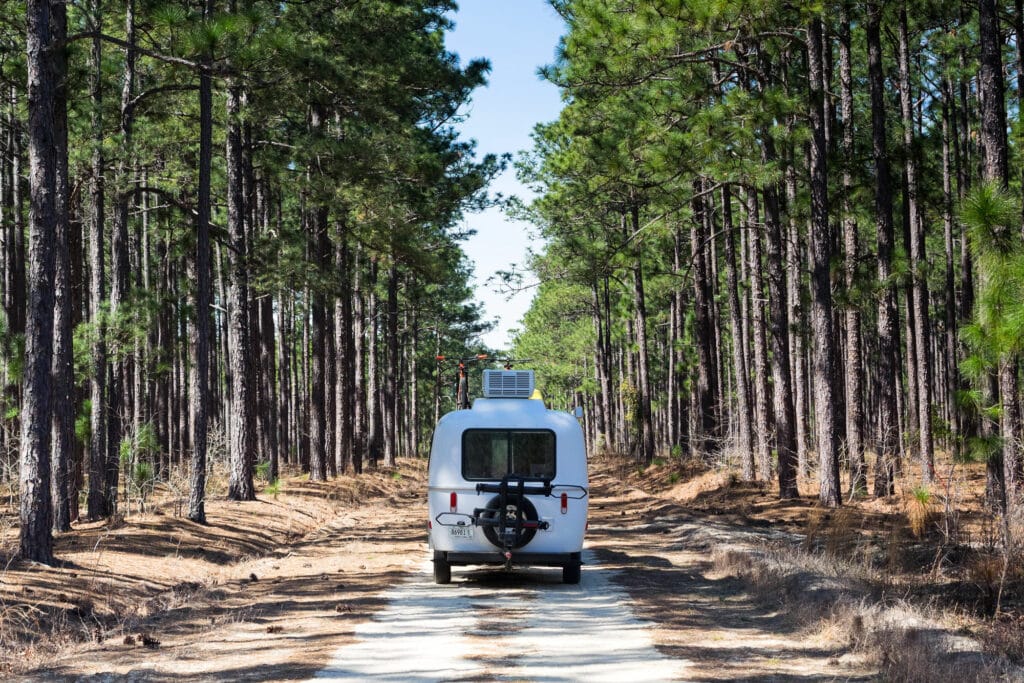
At the visitor center, we were greeted by a friendly ranger, who was more than happy to answer my questions. Fifteen minutes later, she and I were still pulling out maps and talking about realignment plans for the cross-state Mountains-to-Sea Trail to pass through Turnbull. Another fifteen minutes later, and my wife and a ranger-in-training were staring at us with a look like, talking about hiking is boring, just do it already.
So off we went on the Long Trail for a 4.5-mile loop. Along the way there were exhibits about forest products, like timber and pine straw. For a mile the trail followed Turnbull Creek, a pleasant blackwater stream. At the old airstrip there was a lookout tower and forest service Huey helicopter to climb inside. Followed by a mile or two of walking—and sinking into—the soft loam of a logging road.
We still had more to do, like playing disc golf in E-town at Tory Hole Park, site of a Revolutionary War battle. We needed to resolve our latest disagreement about the intricacies of hanging wet towels. We also wanted to paddle at some point. And hike from camp out to Salters Lake, one of the only remaining wilderness Carolina bays. But for now, we trudged along and opened our latest debate: what to name our camper?
“How about Eggs-celente?” I suggested. “It’s shaped like an egg, it’s pretty excellent, and this sounds slightly similar to Rocinante, John Steinbeck’s camper in Travels with Charley.”
“I don’t know,” said my wife. “It looks more like a dairy cow. What about Daisy?”
“Daisy the Dairy Cow-sita?”
“I’ll have to think about that one.”
“Ok, what about…” I spread my arm widely. “It’s the R-gument V.”
My wife rolled her eyes.
“RV,” I went on. “Argument V.”
“Yeah, I got it,” said my wife, clapping sarcastically. “I’m hungry.”
So, we hurried back to have lunch at our Rgument V.
Cover photo by Mike Bezemek.
